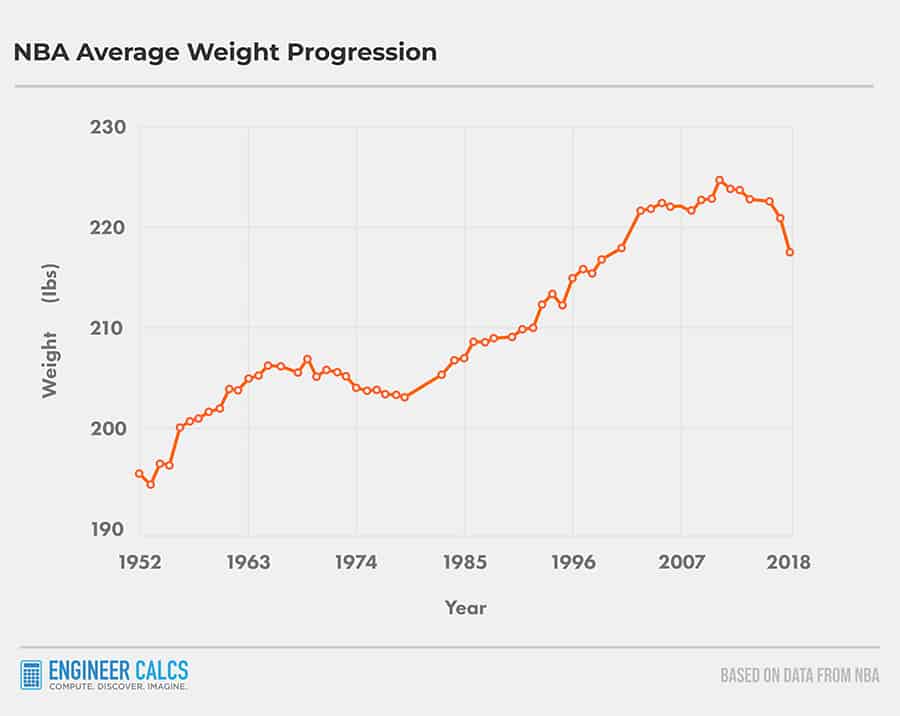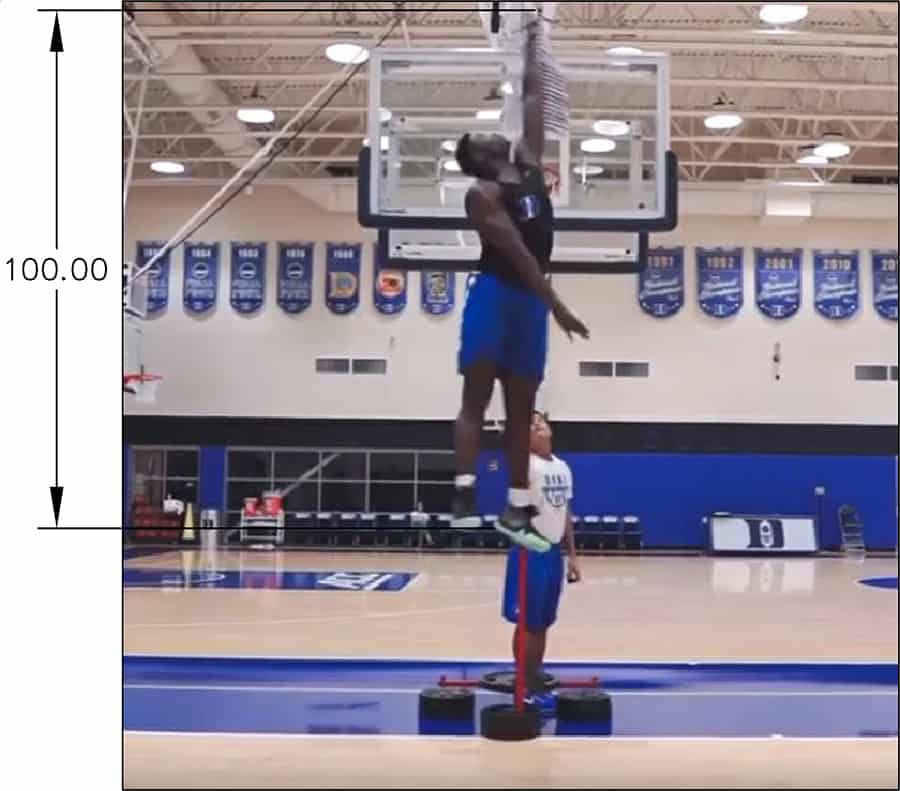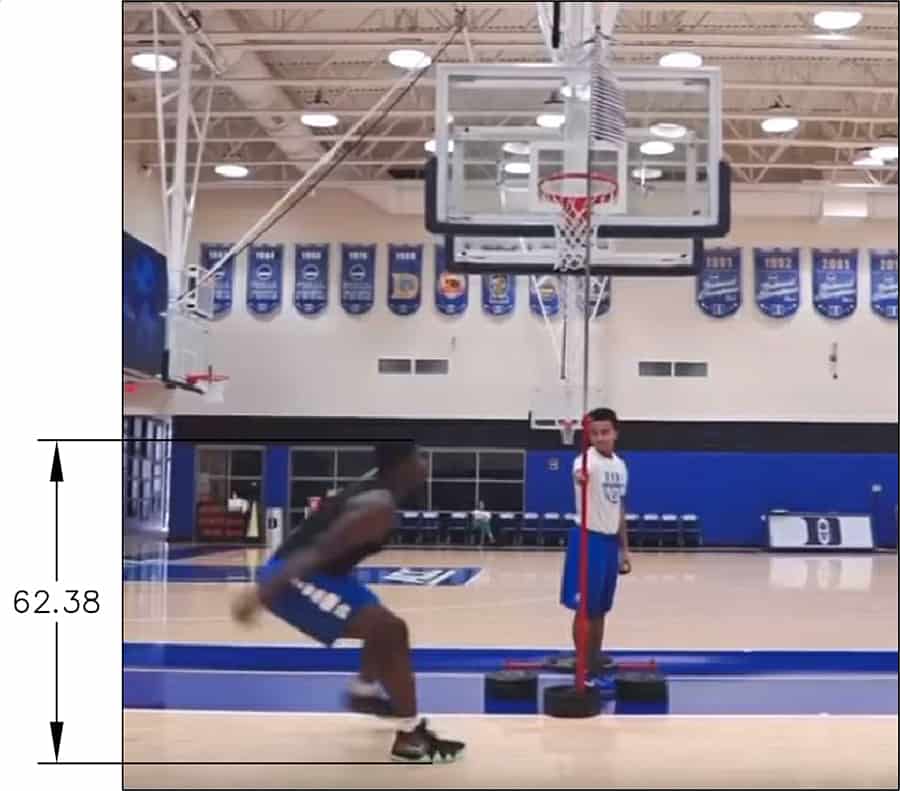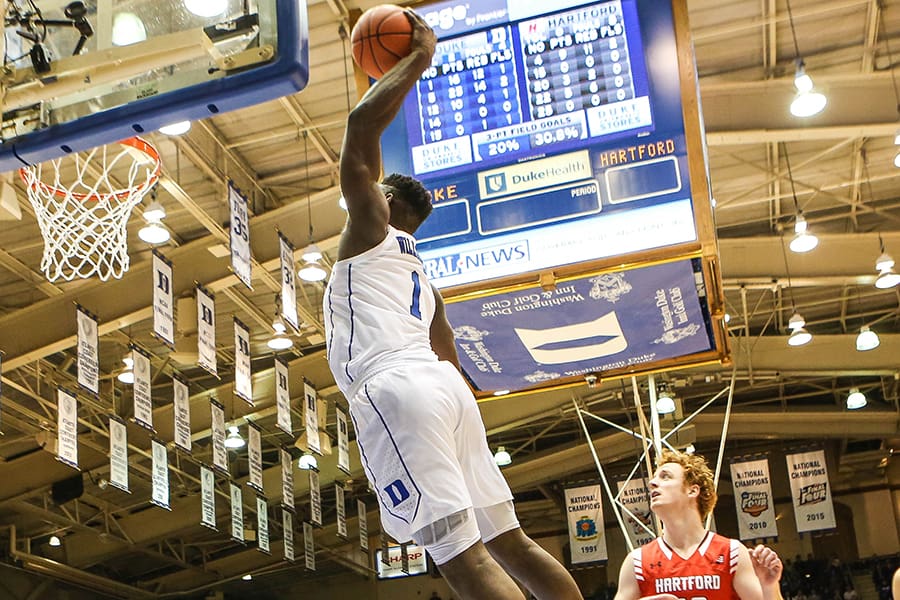Let’s crunch the numbers on Zion Williamson’s vertical jump. This 6’6″ behemoth, tipping the scales at 285 pounds, is an athletic wonder!
Even though he’s built like a tank, Zion’s crazy agile and fast. Just picture Michael Jordan’s spirit trapped inside the body of a top NFL tight-end – yep, that’s Zion for you.
Zion Williamson, a one-man wrecking crew
What really sets Zion apart is his unbelievable combo of size, power, and sky-high skills. Sure, you could compare him to LeBron James, but even at his heaviest, LeBron (6’9”, 250-260 pounds) never came close to Zion’s 285 pounds.
Take a look at this graph showing the average weight of NBA players over the years. Zion’s a whopping 60 pounds heavier than today’s average player, and an astounding 100 pounds heavier than the players of the 1950s!

Defying physics, Zion manages to make his second jumps while his rivals are still coming down from their first.
So, let’s dive into the force behind Zion Williamson’s vertical jump. If you’re not already impressed, you’ll soon understand how this young titan manhandles grown men on the NBA court.
Measuring Zion Williamson’s vertical jump
Let’s journey back to his Duke days to find his peak jumping height.
At Duke’s combine, Zion cleared a 40-inch vertical leap after taking a couple of steps. But for our analysis, let’s go with what his Duke coach, Mike Krzyzewski, said: Zion’s max vertical jump hit a mind-blowing 45 inches!
I’ve seen Zion’s head hover above the rim more than once. Given that the rim is 120 inches off the ground and Zion stands 79 inches tall in shoes, he only needs a 41-inch leap to get there. Very doable.
Vertical jump of Zion Williamson compared to Michael Jordan
To put things in perspective, let’s compare Zion to one of the NBA’s all-time great leapers – Michael Jordan. MJ’s vertical jump with a running start was measured at 45.76 inches back in 1983 at the University of North Carolina.
At the time, Michael was just 20 years old (about the same age as Zion), and during the 1984 NBA draft, he measured 6’6″ tall in shoes, weighing a lean but athletic 195 pounds.
Height-wise, Zion and Michael are pretty much the same. However, Zion’s a whopping 90 pounds heavier, which means he has to lift an extra 90 pounds off the ground with each jump.
To really feel the weight difference, go to your local supermarket, grab 5 pounds of beef, and imagine walking around with it glued to you.
In a nutshell, Michael Jordan’s vertical jump is slightly higher than Zion Williamson’s. But given Zion’s NFL-worthy physique, I find his jumping prowess even more remarkable.
The total calculated force generated by Zion Williamson’s vertical jump
In my calculation, I’ll make a few educated assumptions since I have limited data on Zion.
Step #1: Zion’s launch velocity
Picture Zion soaring off the ground like a human rocket. We can use a kinematic equation to work out how fast he’s going when he blasts off.
Kinematic equations are all about studying motion without worrying about the forces behind it. They just focus on: position, velocity, and acceleration.
Here’s the equation we’ll use:
![]()
Where,
![]() = final velocity (meters/second)
= final velocity (meters/second)
![]() = initial velocity (meters/second)
= initial velocity (meters/second)
![]() = acceleration (meters/second2)
= acceleration (meters/second2)
![]() = displacement, or in our case, Zion’s jump height (meters)
= displacement, or in our case, Zion’s jump height (meters)
At the highest point of his jump, Zion’s velocity will be zero. So, we’ll set ![]() .
.

Assumption: According to his college coach, Mike Krzyzewski, Zion jumps 45 inches (1.143 meters) off the ground.
The acceleration due to gravity acts in the opposite direction of Zion’s jump. So, we assume a negative value for ‘a’ or gravity, ‘g’. Where ![]() .
.
![]()
![]()
![]()
Step #2: Zion’s acceleration when he straightens his legs
Next, we want to know Zion’s velocity right before he leaves the ground. To do that, we need to know how low he squats before jumping.

Assumption: I took a couple of screenshots from a Youtube video of Zion’s max vertical jump at Duke. One picture shows him fully squatting, and the other shows him at the peak of his jump. I used these screenshots to figure out how low Zion squats before pushing off the floor.
Screenshot #1: Zion’s body fully stretched out
At the highest point of his jump, Zion’s body is completely stretched out. His standing reach, according to Duke measurements, is 8’7″ or 2.616 meters. So, in the screenshot, I assumed Zion’s full stretch from toes to fingertips is 2.616 meters.

To make it simple, I converted the 2.616 meters into a unitless 100.
Screenshot #2: Zion’s body at its lowest squat
Using my unitless measurement of 100, I figured out that Zion’s squat measures 62.38. I did this with some basic digital measuring software, which was possible because both screenshots had the same camera angle.

Now, let’s convert the unitless 62.38 measurement back into meters.
![]()
![]() meters
meters
Considering Zion stands 6’7″ tall in shoes or 2.007 meters, we can calculate how far he lowers his body.
![]() meters or 14.8 inches.
meters or 14.8 inches.
Finally, we’ll calculate Zion’s acceleration as he straightens his legs, going from his squat position to right before he leaves the floor.
We reuse Zion’s calculated initial velocity from Step #1 when he leaves the floor. This value now becomes Zion’s final velocity before he leaves the floor.
So, ![]() . Also,
. Also, ![]() because initially, Zion isn’t in motion.
because initially, Zion isn’t in motion.
Now, reusing the same kinematic equation we used before, we get:
![]()
![]()
![]()
Step #3: Calculate the force Zion exerts on the ground in his jump
Zion weighs 285 pounds or 129.274 kilograms, and the net force equation is ![]() .
.
Using the info we’ve gathered, we can now calculate the force Zion exerts in his jump. We do this using Newton’s Third Law of motion, which says for every action, there’s an equal and opposite reaction.
With Zion, the force applied to the floor must equal the sum of the net upward force he generates. This includes his downward body weight, which pulls him back down.
![]()
![]()
Zion’s generated force now comes out to:
![]()
![]()
Visualizing the force generated by Zion Williamson’s vertical jump
When Zion Williamson leaps skyward, he generates an astonishing force of 5,134.25 newtons against the ground. To wrap our heads around this number, let’s break down the newton unit in everyday terms.
A newton measures the force applied to an object. Here are two examples to help you visualize it:
- Imagine a 225-pound person (102 kilograms) standing on top of you. That’s 1,000 newtons of force.
- Picture yourself lifting a 1,125-pound (510 kilograms) weight. You’d be exerting 5,000 newtons.
Could Zion Williamson generate even more force in his jump?

It’s a thrilling question! Zion already produces more force in his jump than any NBA player I’ve ever seen, and he’s just a young pro. As he advances in his career, Zion will hone his body through:
- A tailored diet
- Weight training
- Physical conditioning
- Fine-tuning his jumping technique
Ultimately, it boils down to basic physics. Let’s consider two ways Zion could potentially increase his vertical jump.
Scenario #1: squatting lower before jumping
If Zion squats a bit lower before jumping, he might create even more force. Think of a spring: the more you compress it, the higher it’ll bounce. The same principle applies to humans, up to a point.
Looking back at Zion’s squatting screenshot from Step #2, there’s room for him to squat lower. Combining a lower squat with his rapid leg muscle contractions could be the ticket. Of course, the involvement of his arms and core is also vital for his jump.
Scenario #2: shedding body fat
By losing body fat and becoming a chiseled 260 pounds, Zion might be able to jump even higher. Less weight means less to lift off the ground. Picture a 260-pound Zion soaring nearly 50 inches into the air!
Michael Jordan had a 45.76-inch vertical jump during college. Later in his career, his trainer Tim Grover claimed it reached an incredible 48 inches. Bear in mind, Tim was promoting his Michael Jordan book at the time, so there may be some exaggeration.
Can Zion Williamson’s body handle the force he generates?
The burning question surrounding Zion’s career is whether his body can withstand the force he generates. He doesn’t just jump high and land hard; he also barrels down the lane at breakneck speeds!
Zion’s superhuman abilities carry risks. His body, like ours, is made of flesh and bone. Some worrisome factors include:
- His entire weight dropping from 60+ inches up in the air. Picture Zion, curled up after a dunk, swinging from the rim. Then he lets go and smashes onto the ground.
- Landing awkwardly with all that mass on one foot after a dunk.
- Cutting through the lane and changing directions super-fast, putting extra strain on his knees, especially the ACL.
These concerns only grow if his athleticism continues to improve.
Zion’s body withstanding his unworldly power
Some bodies are genetically ill-suited for intense physical activity. Not everyone can enjoy a long, injury-free career like LeBron James, who’s in his 17th season with hardly a scratch.
For Zion to stay healthy long-term, he should:
- Maintain a healthy diet to manage his weight and reduce inflammation.
- Stay in shape through regular exercise.
- Refine his jumping technique.
- Minimize high-impact actions on the court.
Above all, he needs to watch his weight. The heavier he gets, the more force his joints and tendons have to handle. Human bodies weren’t designed for constant explosive jumps and cuts.
Zion Williamson taking the NBA by storm
Out of the 494 players on the NBA roster list in 2018-19, Zion still sticks out like a sore thumb. He’s a once-in-a-generation athlete, and his jaw-dropping physical attributes make him the center of attention on any NBA court.
As an NBA fan, I’m hoping to see Zion Williamson’s vertical jump reach even greater heights, while he stays healthy for many exciting years to come.
What do you think? Can Zion’s vertical jump keep soaring? Do you see any injuries in his future, given his high-octane playstyle?
Featured Image Photo Credit: Keenan (image cropped)

I think you ask a very important question here, which is “Can Zion Williamson’s body handle the force he generates?” Something I wondered as soon as I saw him play. Apparently the answer is “no”, which is a shame, because what we’ve seen so far from him was so amazing.
Agreed; I hope he can turn it around. Because the force he generates is mindblowing. I find Zion much more athletically impressive than a young Derrick Rose, given his sheer mass.